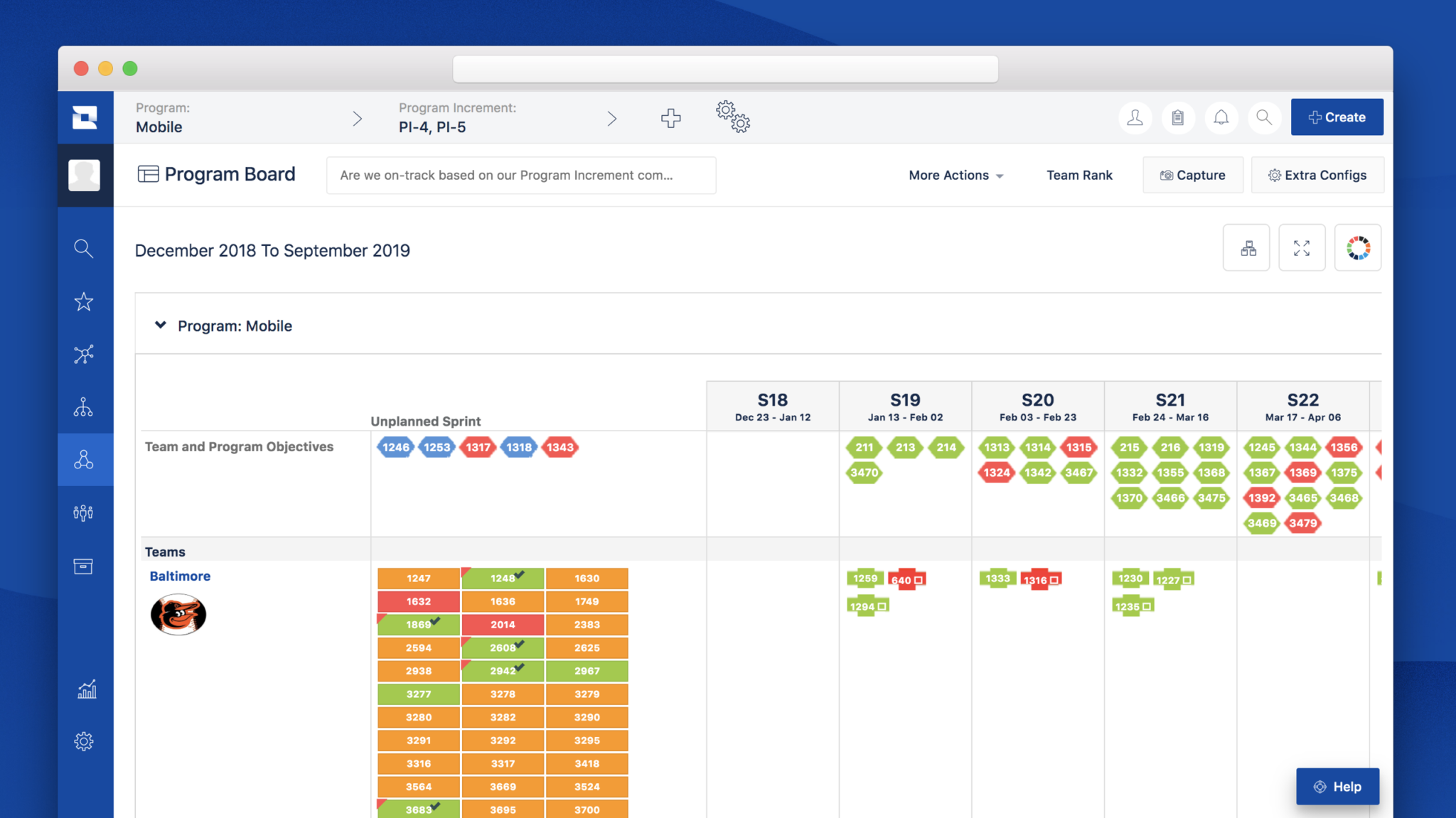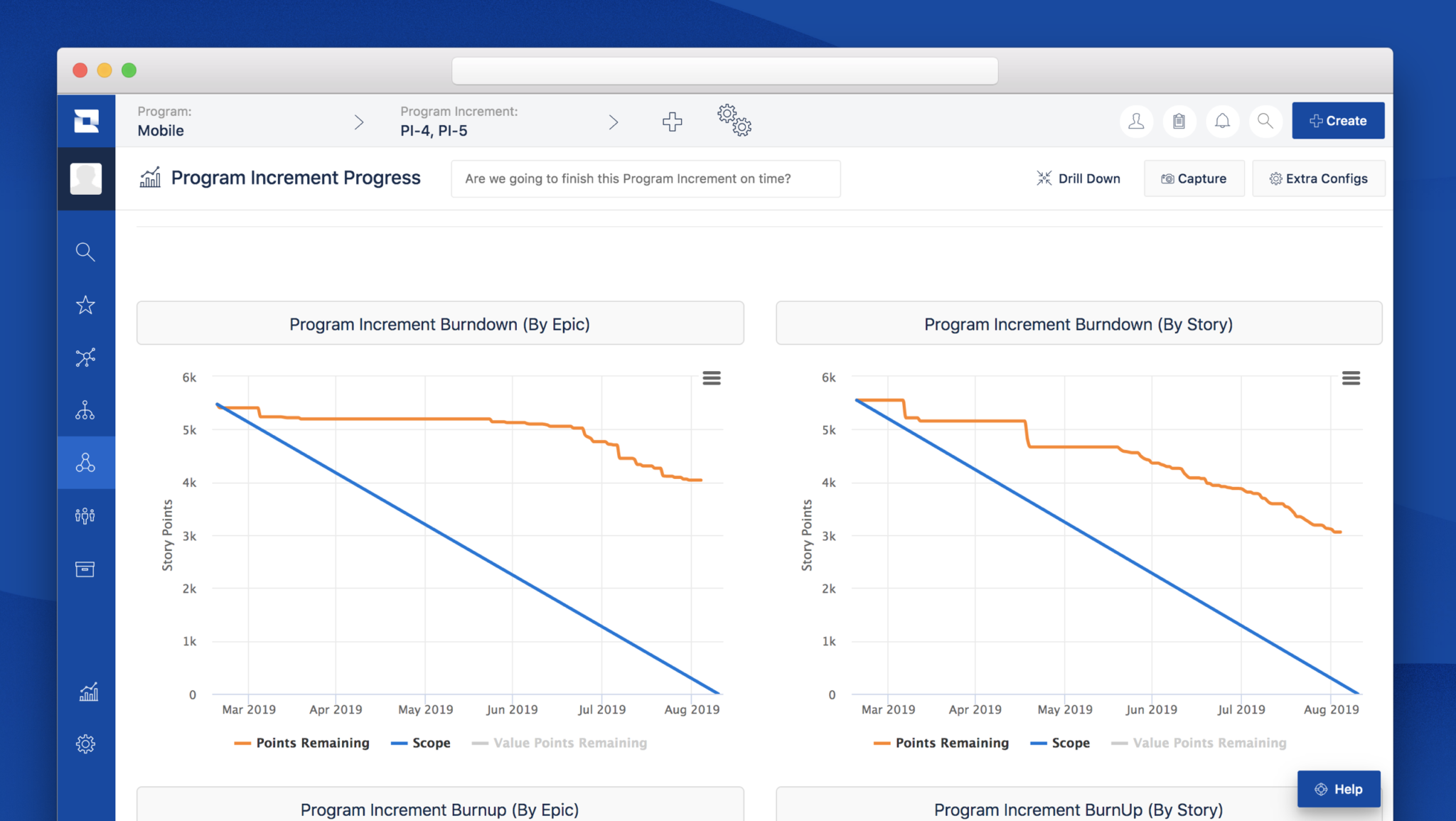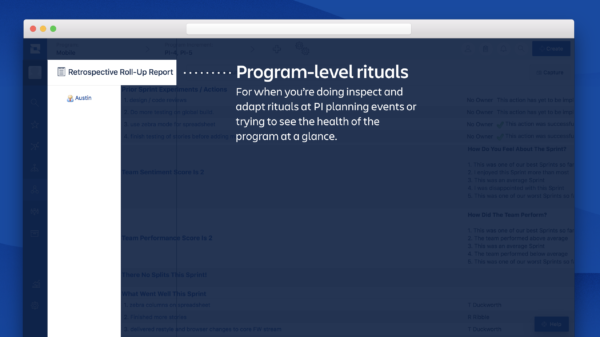4 tools you need to build an agile program management powerhouse
Continuous improvement, made manageable.
If you’re a program manager, or are lucky enough to work with great ones, you know they’ve got a tough job to do. They bring teams together, establish and facilitate communication and planning best practices, and are always looking around corners to make sure future roadblocks can be removed and teams have their best chance to deliver work on time.
In an agile environment, program management presents an even bigger challenge – keeping track of many simultaneous pieces of work being delivered across teams working in parallel. Program managers are the soul of servant leadership on scaled agile teams. They need top-to-bottom transparency and insights into all aspects of their programs or release trains. This can only be accomplished when all the elements of the program and associated data can be intelligently connected.
To expose and enable what’s truly important to running successful programs and release trains, we’ve spent time collaborating with customers as they transform their companies to uncover unique insight into the best way to work with these groups across PIs.
Based on plenty of challenges, successes, failures, learnings, and iterations over thousands of hours, we’ve identified the four key tools needed to create a powerhouse that helps the PM or RTE keep programs and release trains moving. Following the model of a well-organized workshop, all the tools for successful agile management should be designed for tackling the key activities involved in programs and ARTs.
A robust agile program management powerhouse should have four key tools:

- An overview of unified key program information, such as feature progress, objectives, dependencies, and risks, in a configurable, at-a-glance format.
- A real-time information radiator focusing on the current quarterly plan (or program increment) by sprint and team, with the ability to drill down into detail on any object and start removing blockers before they impact delivery.
- Real-time, up-to-date, confidently accurate reports to measure, forecast, and communicate program and release train health and progress data.
- A proactive set of inspect and adapt activities that are conducted, recorded, actioned, and driven to resolution with measured results.
A unified view of key program information (Program Room)

The heartbeat of the program or PI is captured in the Jira Align Program Room. This dashboard is a powerful snapshot of everything an agile program manager or RTE needs to quickly understand every aspect of the critical activities in a given program, PI, ART, or sprint. It removes the heavy impediment of generating suites of manual reports and delivers PMs/RTEs elegantly visualized, accurate, real-time, up-to-date information on the key aspects of the program. This is the cornerstone of the Jira Align program management powerhouse, where you will find the key elements that are needed to make the daily life of PMs and RTEs clearer, easier – and just plain better:
- Process guidance designed to guide you through all the critical parts of PI planning, backlog creation and grooming, tracking and optimizing work in progress, and the identification and management of dependencies.
- Work progress relative to PI commitments and how that might impact commitments.
- Monitoring team velocity for anomalies or improper loading trends.
- Highly visible risks and dependencies, visible as “first class citizen” program artifacts.
- Flexible views of feature and epic completion progress.
- Inter-team messaging and chat, enabling better understanding of team daily life, story progress, and release DevOps issues.
- An overview of runway for epics, capabilities, features, and stories with goals and actual results, enabling visualization of capability vs. plans.
A real-time information radiator (Program Board)

While the Jira Align Program Room highlights the many moving parts between the team and program level, the Program Board provides a clear view that focuses squarely on the PI and progress of the sprints within relative to program objectives and the teams working on it. Unlike the analog program boards used in PI planning, our digital board is updated in near real time as changes occur making it a comprehensive, fast way to measure the PI health, and also the primary point of analysis for the PM/RTE.
- Features, dependencies, and objectives are broken out by each sprint of the PI.
- Progress is color-coded, so completed items and risks and problem areas are immediately made visible.
- Visibility in real time when the plan changes.
- Each feature can be drilled down to see the stories, risks, and dependencies associated with it. Each of these objects can be further drilled down into detail view.
Real-time, accurate reports (Program Reporting)

A set of program reports will facilitate insights into key metrics that show program progress and health. This will help you and your team identify any red flags, which may be important team or program impediments.
Make sure you have at your disposal:
- The best dependency management solution available, including multiple inter-team/program visualizations and the ability to filter epics, features, and capabilities.
- Everything you need to know about releases, including burn-up and burn-down charts, as well as release vehicle progress and contents.
- The work associated with achieving objectives and progress toward completion.
- Innovative ways of viewing and organizing work and product idea through story maps, functional maps, and a work tree, with an eye to linking work to strategy, objectives, and themes.
- Forecasting and program predictability reports that take historical data and facilitates more informed decisions about future program and PI increment commitments.
Enablement for continuous improvement (Inspect & Adapt Activities)

Continuous improvement is at the heart of any agile program, and as the scale increases, so does the complexity around this. RTEs and PMs need to facilitate this regularly and easily. Transformation activities such as team retrospectives and inspect & adapt sessions are recorded and made actionable to deliver into the backlog.
- Assessments allow the team to provide candid input about how they feel about achieving specific objectives, and solicit ideas for how to implement positive change.
- Retrospective summaries allow teams to rank sprint effectiveness and PMs/RTEs to drive any actions that result from the event.
- Definition of done creates the baseline against which teams can continually assess whether quality and feature objectives are being met.
A robust, proven set of powerhouse tools designed specifically for the agile PM and RTE is the best way you can set your organization up for success. Programs and release trains can increase efficiency and make progress faster using these four simple toolboxes.
Want to chat more about agile program management with the experts? Visit the Jira Align Community today and participate in this discussion with me and other Jira Align program management enthusiasts.
If you’re scaling your agile programs to the portfolio level and beyond, Jira Align delivers these tools with style and ease while giving you the power to choose only the tools that matter to you. Visit us today and sign up for an overview of our program management solution – we’d love to show you around.
